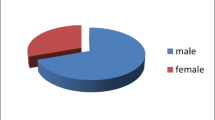Abstract
In order to determine the epidemiology of tinea cruris in São Paulo, Brazil, an investigation was carried out from April 95 to March 1997. A total of 2000 individuals were studied, of whom 105 were suspected of having tinea cruris infection. Direct microscopy and/or culture were positive in 66 [62.8%] of the cases. Erythematous-scale plaques and erythematous-liquenificated plaques were the most frequently found clinicaltypes. T. rubrum was the prevalent dermatophyte in 90% of the cases, followed by T. tonsurans (6%) and T. mentagrophytes (4%).
Similar content being viewed by others
References
Al-Sogair SM, Moawad MK, AL-Humaidan YM. Fungal infections as a cause of skin disease in the eastern Province of 149 Saudi Arabia: tinea corporis and tinea cruris. Mycoses 1991; 34: 423-427.
Campbell I, Campbell G, Aguirre L, Santos MG. Dermatófitos em Brasilia. An bras Dermatol 1984, 59: 224-225.
Chakrabart A, Sharma SC, Talwar P. Isolation of dermatophytes from clinically normal sites in patients with tinea cruris. Mycopathologia 1992; 120: 139-141.
Costa TR, Costa MR, Da Silva MV, Rodrigues AB, Fernandes OF, Silva MR. The etiology and epidemiology of dermatophytoses in Goiania, GO, Brazil. Rev Soc Bras Med Trop 1999; 32: 367-371.
Davel G, Perrotta D, Canteros C, Cordoba S, Rodero L, Brudny M, Abrantes R. Estudo multicéntrico de micosis superficiales en Argentina. Rev Arg Microbiol 1999: 31: 173-181.
Gonçalves HMG, Mapurunga ACP, Queiróz JAN, Diógenes MJN. Dermatofitoses: principais agentes etiolóogicos identificados em Fortaleza. An bras Dermatol 1989; 64: 25-27.
Kaszuba A. Seneczko F, Lipowczan C, Bienias L, Kostuziak M, Lupa S. Fungal flora in human skin and skin appendages infections in the region of Lódz, Poland. Mycoses 1998, 41: 249-253.
Kemna ME, Elewski BE. A U.S. epidemiologic survey of superficial fungal diseases. J Am Acad Dermatol 1996; 35: 539-542.
Khosravi AR, Aghamirian MR, Mahmoudi M. Dermatophytoses in Iran. Mycoses 1994, 37: 43-48.
Korstanje MJ, Staats CC. Fungal infections in the Netherlands. Prevailing fungi and pattern of infection. Dermatology 1995; 190: 39-42.
Mangiaterra ML, Giusiano GE, Alonso JM, Pons De Storni L, Waisman R. Dermatophytosis in the greater Resistencia area, Chaco Province, Argentina. Rev Argent Microbiol 1998; 30: 79-83.
Manzano-Gayosso P, Méndez-Tovar LJ, Hernández-Hernández F, López-Martínez R. Dermatophytoses in Mexico City. Mycoses, 1994, 37: 49-52.
Mattêde MGS, Coelho CC, Mattêde AF, Perin F C, Palhano Jr. L. Etiologia das dermatofitoses em Vitória (ES). An bras Dermatol 1986, 61: 177-182.
Maraki S, Tselentis Y. Dermatophytoses in Crete, Greece, between 1992 and 1996. Mycoses/l998, 41: 175-178.
Marchisio VF, Preve L, Tullio V. Fungi responsible for skin mycoses in Turin (Italy). Mycoses 1996; 39:141-150.
Mendes Tovar LJ, Lopez Martinez R, Macotela Ruiz E, Manzano Gayosso P, Serrano Jean L, Carmona Castañon A, Mondragon Gonzales R. Variación en la frecuencia de micoses en México. Rev Argent Microbiol 1999, 31: 107-113.
Mezzari A. Frequency of dermatophytoses in the metropolitan area of Porto Alegre, RS, Brazil. Rev InstMed Trop Sao Paulo 1996; 40: 71-76.
Nowicki R. Dermatophytoses in the Gdansk area, Poland: a 12-vear survey. Mycoses 1996, 39: 399-402.
Omidynia E, Farshchian M, Sadjjadi M, Zamanian A, Rashidpouraei R. A study of dermatophytoses in Hamadan, the governmentship of West Iran. Mycopathologia 1996; 133: 9-13.
Ponnighaus JM, Clayton Y, Warndorff D. The spectrum of dermatophytes in northern Malawi (Africa). Mycoses 1996; 39: 293-297.
Rippon JW. The changing epidemiology and emerging patterns of dermatophytes species. Curr Top Med Mycol 1985; 1: 208-234.
Rippon JW. Dermatophytosis and dermatomycosis. In: Medical mycology: the pathogenic fungi and the pathogenic actinomycetes. Philadelphia, W. B. Saunders, 1988. Cap. 8, p. 169-275.
Sabouraud R. Trichophyties. In: Les Teignes. Paris, Masson et cie, 1910. Cap. 6, p. 420-434.
Zaias N, Rebell G. Chronic dermatophytosis syndrome due to Trichophyton rubrum. Int J Dermatol 1996, 35: 614-617.
Author information
Authors and Affiliations
Rights and permissions
About this article
Cite this article
Silva-Tavares, H., Alchorne, M. & Fischman, O. Tinea cruris epidemiology (São Paulo, Brazil). Mycopathologia 149, 147–149 (2001). https://doi.org/10.1023/A:1007288602016
Issue Date:
DOI: https://doi.org/10.1023/A:1007288602016




